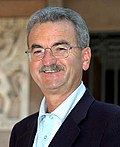This article needs additional citations for verification .(January 2021) |
 |
|---|
|
There have been ten presidents of Umbria since its proclamation in 1970.
Contents
As established by the art. 114, second paragraph of the text, the region of Umbria was established, and the first regional elections took place on 7 June 1970. Until 1993 the presidents were elected by the regional council and following the 1995 reform, the election of the president of the region is by universal and direct suffrage.
Since 2000, all directly elected presidents of Umbria have been women. Umbria has the largest number of mandates won by female presidents out of any region of Italy, [1] with six mandates won by four separate women.
The youngest president at the time of the elections was Pietro Conti, who took office at the age of 41; the oldest was Maria Rita Lorenzetti, who finished her term at the age of 57. Germano Marri was the president who presided over most, elected three times and with the longest mandate, with 10 years, 11 months and 6 days, while Francesco Ghirelli with the shorter mandate.
The Italian Communist Party is the party that has included most of the presidents (three), having governed from 1970 to 1992 with the Italian Socialist Party.
The most durable junta was the first Marini junta, with 5 years, 2 months and 1 day, while the shorter one was the first Ghirelli junta.










